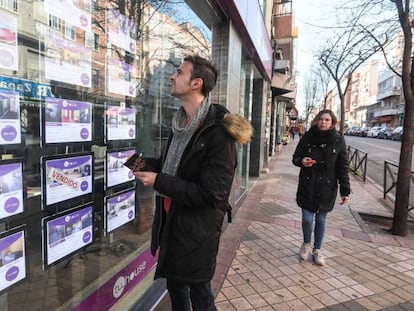Why young Spaniards are taking longer than other Europeans to leave home
Some 64% of people between the ages of 25 and 29 still live with their parents in Spain, double the figure for France and Germany, while those who have moved out are spending a large chunk of their salary on rent
There is one big issue that is having a major impact on young people’s lives in Spain: the labor market, with its scourges of temporary contracts, high unemployment and low wages. The impact of this problem is reflected by the fact that most Spaniards still live with their parents at least until they turn 30. To talk about young people’s lives is to talk about property – their desire to buy or rent it and the economic effort required to do so.
1. More young Spaniards live with their parents than in most of Europe. The average age for leaving home is around 30, three years more than the European average. According to data from the European Union’s statistics office Eurostat, 64% of people between the ages of 25 and 29 live with their parents in Spain, a figure trumped only by Italy, Greece and a number of Balkan countries. This is more than double the rate in France (17%), the United Kingdom (25%) and Germany (30%) and in stark contrast to Nordic countries where only 5-6% in this age bracket are still living with their parents.
The number of young people in Spain who have not become independent increased with the fallout from the 2008 financial crisis. Now with the coronavirus pandemic, the number will almost certainly rise again, as data from the Emancipation Observatory indicates. There are many reasons why youngsters remain in the family home for so long, but the obvious one is money. According to a survey by the government youth institute Injuve, 75% of young people cite lack of economic stability as the reason for not moving out. Those who do go it alone are often left with a meager amount of money to live on after the rent is paid: 34% of independent 25- to 29-year-olds are at risk of poverty or social exclusion, more than in any other European Union (EU) country, according to Eurostat.
2. Young people are increasingly living in rented properties. Another big change in the last decades has been the growing preference for renting over buying a home. In 2006 and 2007, there were twice as many owned homes as rented ones among households whose primary wage earner was under 30. But that ratio has gone into reverse: now 50% are renting and only 25% are buying.
Another significant trend is that there are now twice as many young households living in a home that has been given to them for free or at a reduced price. In 2006, this kind of setup accounted for 10-15% of young households, whereas it now accounts for 26% of the total. In other words, one in four young households are dependent on another’s goodwill.
There are 600,000 households in which the primary wage earner is 30, representing just 3.5% of the total, which is practically half of what it was 15 years ago. There are also fewer households inhabited by the 30 to 44 demographic (26%), while the number of older households has risen – those in which the main breadwinner is between 44 and 65 account for 41%, and households depending on someone of retirement age now account for 29% of the total.
The growing preference for renting is also evident in households between 30 and 44, although owning a house is still predominant (60%) in this demographic. Spain continues to be a country where more families own their own homes compared to the EU average – 76% compared to 70%, according to Eurostat.
3. Paying rent is an effort for 50% of young households. In Spain, many people live in rented homes because they cannot afford to buy – although they would like to – and are forced to stretch the family budget in order to pay the monthly rent. In this respect, the economic effort in Spain is among the greatest in Europe.
For example, the data for couples with a child living in a rented property in Spain shows that almost 30% of their income goes on rent on average, which is more than any other country in the EU. Similarly, data for households consisting of a couple with no children or one adult and a child, is the worst in the entire EU.
It is generally considered inadvisable to spend more than 30% of household income on rent. But in Spain, the majority of people living in rented accommodation pay more than 30%. Based on microdata from the Living Conditions Survey, we have calculated that 46% of households living in rented properties at current market prices have to spend more than 30% of their income on rent. This puts them in a situation where they are overstretched economically. With regard to young people, the figure rises to 51%.
The effort is especially intense in large cities. In Madrid, 58% of all households in rented homes spend more than 30% of their total income on rent; in Catalonia, this figure is 49% and in the Balearic Islands 47%.
Naturally, differences arise according to a household’s makeup. Sixty-nine percent of single mothers or fathers are in a situation where they are over-stretched economically, as are 75% of women living alone and 50% of families with three children or more.
4. For buyers, the price of leaving home is around €1,600 per square meter. The difficulty of leaving home is simply that young people are generally on low incomes and properties are expensive. Since the 2008 economic crisis, the value of property per square meter has been pegged to the evolution of unemployment. Prices stopped rising when unemployment began to escalate in 2007. At its peak, the value per square meter exceeded €4,000 on average in Madrid and Barcelona, dropping back to €2,500 by 2015. By then the economy was improving. There was more work and prices rose again and now hover around €3,200 per square meter in Madrid and Barcelona.
The most expensive provinces are Gipuzkoa and Vizcaya in the Basque Country, Madrid, Barcelona and the Balearic Islands, where the sale value per square meter is 40% more than the national average. The same applies to rents. The average cost of renting a 75-square-meter property is around €875 in the province of Madrid and around €750 in Barcelona, but only €315 in Lugo in Galicia or Castellón in Valencia.
Large cities are especially expensive. As can be seen in this link showing an alternative map, the typical apartment in Madrid and Barcelona costs close to €850 to rent, while in Málaga it is around €620; in Valencia, €520; and in Murcia, €460. These differences are accentuated depending on neighborhoods or municipalities. In Madrid and Barcelona, the gaps become enormous; in both cities, there are hundreds of neighborhoods where the average rent for an apartment is below €700, but then a dozen districts where there is nothing below €2,000.
Finally, the search engine below allows you to consult the data of hundreds of locations across Spain. There are municipalities around Barcelona, near Madrid and in the Balearic Islands where the price per square meter exceeds €3,000 and where the highest rents, which are 25% more expensive than the national average, exceed €15 euros per square meter. On the other hand, in areas of inland Spain, such as Villarrobledo in Albacete or Puertollano in Ciudad Real the price per square meter barely reaches €600.
English version by Heather Galloway.

